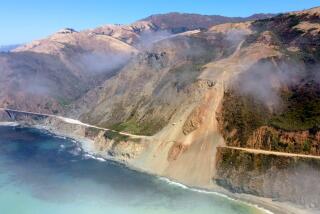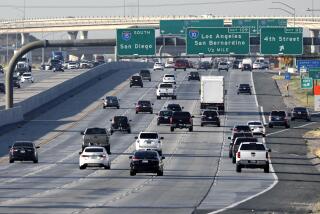Highway Repairs On Steep Climb
- Share via
The cost of repairing storm-damaged state highways in California has reached $85 million and is expected to climb, Caltrans officials said Saturday.
The new figure comes before winter has reached its midpoint, with the possibility that more storms could further overwhelm roads across the state, particularly Interstate 5 north of Santa Clarita, which is open but threatened by an area prone to landslides.
At least $43 million in road repairs is needed in Southern California, where some key mountain highways remained closed this weekend.
These include California 33 north of Ojai, California 150 east of Santa Paula, California 39 in the San Gabriel Mountains north of Glendora, and Topanga Canyon Boulevard through Topanga Canyon, according to Caltrans.
For now, the money to fix state roads is expected to come from Caltrans’ existing budget. Caltrans officials say they have received preliminary word that the Federal Highway Administration will reimburse most of those costs.
“At this point, no funds have been diverted from other transportation projects. We have to wait and see the amount of money forthcoming from the federal government,” said David Anderson, a Caltrans spokesman. “Once we have the figure, we’ll know where we stand.”
Cities and counties across the state are grappling with the cost of repairing their own roads and could benefit from federal disaster assistance -- if it comes through.
Transportation advocates have complained in recent years that funds for road and other transit projects have increasingly been diverted to other uses during the state’s fiscal crisis, resulting in reduced road maintenance in the state.
“We seem to have our fair share of natural disasters year in and year out, be it floods, earthquakes and landslides, and we have neglected roads for such a long period of time,” said Michael Lawson, executive director of Transportation California, a Sacramento-based coalition of business, labor and local government officials.
“Our transportation system resembles more that of a Third World country than a state-of-the-art system that we had in the 1960s.”
The state has admitted there are problems.
“California’s transportation program is in crisis and on the verge of collapse,” began a December report by the California Transportation Commission.
” ... Meanwhile, the backlog of pavement and other rehabilitation needs on the state highway system is growing, and the cost to meet those needs is increasing and more and more work is deferred.”
Most of the damage to state roads occurred in the mountains, where rainfall was often the heaviest.
In Southern California, the big problem came when landslides in the mountains dumped tons of dirt on roadways, and torrential rains undermined the foundation of roads or washed out bridges.
One of the most troublesome areas remains a 4,000-foot stretch of hillside bordering the southbound lanes of Interstate 5 north of Santa Clarita.
Ground water is still flowing through the hillside and causing it to move, the result of a process known as hydrostatic pressure, said Doug Failing, director of Caltrans’ District 7, which covers Los Angeles and Ventura counties.
In response, Caltrans crews are drilling horizontal holes in the side of the hill in an effort to drain it before it slips again.
In Northern California, the problem was prolific snowfall. Caltrans has spent millions plowing roads in the last month, often trying in vain to beat back the weather.
In the Sierra Nevada, parts of the Lake Tahoe basin received up to 13 feet of snow in a two-week span after Christmas. That buried several roads for long stretches. Interstate 80, the only freeway to cross the Sierra and a major east-west trucking route, was closed for 39 hours during recent storms, including one 14-hour stretch. Caltrans officials say that is the longest in years.
Simultaneously, U.S. 50, the other major route across the Sierra, was also frequently shut down because of avalanche control on a precarious stretch where the road clings to the side of a mountain east of Echo Summit. In that case, Caltrans crews spent long hours blasting snow from cliffs above the road and then clearing it from the pavement.
“Even though the highway is closed, it’s not like our equipment isn’t out there working. If we just let it go, it would be even worse,” said Mark Dinger, a spokesman for Caltrans’ District 3, which includes the region.
The eastern Sierra has also been hammered by storms. It has snowed 21 of the last 35 days at Mammoth Mountain, resulting in 226 inches of snow and 41 in the last week. The resort says its season total is now 372 inches.
Meanwhile, Caltrans is continuing to issue contracts for repairs across the state.
“Let me give you a comparison: A couple of weeks ago, we had 45 emergency contracts valued at a little over $33 million,” said Anderson, the Caltrans spokesman.
“Now we have 58 emergency contracts worth over $46 million, so you can see how that number is going up.”
More to Read
Sign up for Essential California
The most important California stories and recommendations in your inbox every morning.
You may occasionally receive promotional content from the Los Angeles Times.










